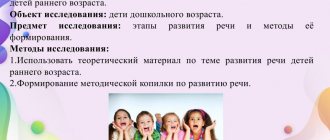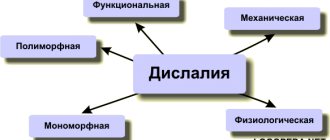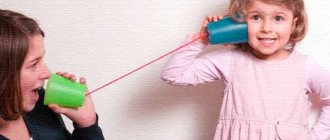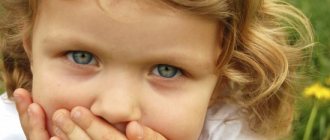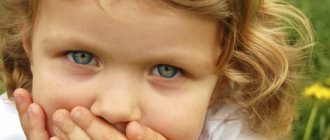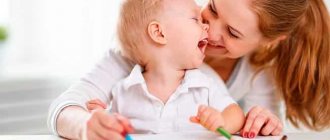An important question for caring parents is when a child should speak and whether he needs help in starting speech. We will talk about what speech skills should be developed during certain periods of a child’s development. Let us explain what attentive parents should pay special attention to so as not to miss the moment when the baby needs family help. Let's list the signs when you will have to call a child to speak with the help of specialists. Let’s find out which specialist is best to contact.
But in any case, the main helpers for a non-speaking child will be parents. Therefore, in addition, we will provide useful games and exercises and show you how best to carry them out, taking into account the age and characteristics of your baby’s speech development.
- Evoking speech in a non-speaking child at 1-2 years old
- Evoking speech in a non-speaking child at 2-3 years old
Which aspects of speech require parental attention?
When we talk about how speech is initiated in children, we mean
- The child’s active vocabulary (own speech)
is the sounds, words and phrases that the child himself pronounces. - passive vocabulary (speech understanding)
are words and phrases that the child cannot yet pronounce, but he understands them.
Understanding the speech of other people develops before the child begins to speak. This means that the baby’s passive vocabulary is always greater than the active one, that is, he understands more words than he himself can pronounce.
It is necessary to analyze both of these sides, because the delay can affect either one of them or both at the same time.
What is considered normal speech development for a child under 1 year of age?
Speech development occurs in a child from the moment of birth. There are certain norms, stages and timing of speech formation. Dear Parents! Please remember that each child is individual, he has his own initial speech abilities, so 100% compliance with the requirements and standards is rare.
There are children who develop faster than normal, and some who develop more slowly. As a result, both of them master speech equally. It is more important to understand that the child will definitely go through ALL of the development steps listed below. If he lingers longer at one stage, this does not mean that he can “skip” the next stage. Therefore, information about standards should be treated as a guideline - at what stage are we now, what and when should we expect next?
For more information about the norms of speech development, see here.
- 2 months
– the child screams with different intonations. Experienced mothers know how to determine “what” their child is screaming about. When the baby sees his mother, he develops a “revival complex” when he intensively moves his arms and legs and makes sounds: aa, e, kg, gh, gee. It can make you happy with a smile in response to a gentle intonation. - 4 months
- booming: gee, gah, yay. Laughs loudly, cries with tears. - 6-8 months
- babbling. Repeats the same syllable. Ba-ba-ba, na-na-na, la-la-la. - 12 months
– the child understands his name. Understands the question “Where is mommy?” and meaningfully names close people (mom, dad, grandfather). Understands the word “Give” and uses this word in speech. Understands the word “No”, can say it or simply shake his head negatively.
We analyze the readiness of the sensory system for speech development. The first signs of trouble.
A child’s speech is a logical continuation of acquaintance with the world through sensory systems - vision, hearing, touch, smell. Without their proper functioning, timely speech development will be problematic. In the first six months of life, the child’s speech capabilities are minimal, but attentive parents can detect the first signs of trouble:
Are the movements active enough?
Lethargy and limited movement of the limbs, reluctance to take toys, the absence of a “revival complex” for 2-3 months is a sign of trouble and a reason to contact a pediatrician.
Is your child's sense of touch sufficiently developed?
The first test for the development of touch is for an adult to place his finger in the newborn’s hand. Feeling a touch on the palm, the baby will reflexively squeeze his fingers. Later he will hold the toy, first with his palm, then with 2-3 fingers. A reaction to warm or cold food or objects indicates a developed sense of touch. If there are no tactile reflexes, you need to undergo examination by a neurologist.
Does your child see well?
After the first month of life, the baby fixes his gaze on the face of an adult, on bright toys or objects. A little later, he follows with his eyes the objects that adults move in front of his face, the carousel moving above the crib. If this does not happen, you need to contact your pediatrician or ophthalmologist.
Does your child hear well?
Hearing is the leading function, without which it is impossible to master speech. Normally, a newborn begins to listen to sounds at 3-4 weeks. Then the baby turns his head towards the source of the sound. When talking to him, he focuses on the adult's lips as the source of the sound. If the baby does not react to loud sounds or does not turn around when his name is called, you need to contact an otolaryngologist or audiologist.
What to pay attention to
When should you start sounding the alarm? So, this is necessary in cases where:
- The babbling chains of children are homogeneous, rare, and do not turn into words.
- By the age of 1.5 years, the intonation-rhythmic organization of speech in the baby is not formed.
- At 2-3 years old, a child does not understand speech addressed to him, even if an adult uses monosyllabic sentences and simple words.
- The child understands, but does not speak, or uses only a few words in communication. There is no phrasal, and especially coherent, speech.
- Physiological hearing impairment (deafness, hearing loss) was detected.
- The baby “speaks” in some kind of his own (bird) language, which no one understands.
How to properly develop the sensory system to trigger speech
The sensory system can and should be developed from a very early age. Below we present games that can be played starting from 1 month from birth
.
Games to develop tactile sensitivity up to one year
“Bay, bay, smack.” We sing a lullaby to the baby while holding him in our arms. After each line we kiss on the cheek, on the nose, on the forehead.
“Grab it.” Place your finger in the baby's hand. When he grabs it tightly, pull the child by the arms, lifting him up.
"Breeze". Blow on the arm, leg, nose and other parts of the body and face, naming them.
Games to develop visual perception up to one year
"Look at me". We lean over the baby and talk to him. When he concentrates, you need to move to the right, to the left.
"What we see." Bring the baby to the mirror, show where his nose, arms, cheeks and other parts of the body are in the mirror.
Games for the development of auditory perception up to one year
“Where is it ringing?” Ring the bell while standing so that the child does not see the source of the sound. Let him look for where it rings. You can use jars of cereals and beans, children's musical instruments.
"Musical sock" Sew a rattle to the baby's sock and put the sock on a leg or arm. Have him move his leg, trying to catch the rattle with his hand.
"Favorite Poems" While awake, it is very useful to tell children poems or talk to them all the time. Rhythmic lines help evoke speech in non-speaking children.
Causes and mechanisms of the disorder
The reasons may be social or biological. The first group includes:
- Lack of communication (verbal, emotional) between adults and the child. The experiment with infants is based on comparing the psycho-emotional state of the subjects. For a certain period of time, some newborn children were placed in a room with white walls, isolated from extraneous sounds and other external stimuli. The children were not picked up; they were only given the necessary care. In another room there was a second group of subjects, where a favorable environment was created, the babies were not only fed and swaddled, but also picked up, rocked, and talked to. At the end of the experiment, when summing up the results, it was noted that the mental development indicators of the children of the first group were significantly lower than those of the children of the second. This experience confirms the fact that the lack of an emotional connection between mother and child and a lack of communication can further negatively affect the formation of speech.
- Using multiple languages in the family. Bilingual children are the name given to those who are raised in a bilingual family. If a child is exposed to speech in different languages, then at some point “stupor” may occur. Speech therapy work with such children should be carried out only in one (leading) language; if this condition is neglected, the situation can be aggravated. It is also undesirable for several speech therapists to work with the child, since different specialists may choose different methods for training, which will only complicate the perception of new material.
Biological reasons:
- Difficult or unnatural labor (eg, caesarean section and prolonged labor).
- Fetal hypoxia (lack of oxygen) during intrauterine development, which in turn leads to disruption of metabolic processes and a delay in the formation of the central nervous system.
- Birth injuries in a newborn: if the cerebral cortex is damaged, if the speech zone is affected, the manifestation of pathology will definitely be the consequence.
- Head injuries, especially at an early age.
- Infectious diseases suffered in the first year of life, which subsequently caused complications.
How speech develops up to a year. Norm and delay
Under one year of age
understanding of speech begins to form. The child establishes a connection between an object and the word denoting it. After several repetitions and showing the object, he himself finds it after an adult’s question (“Where is the watch?”, “Where is the dog?”).
Up to 12 months
The baby’s active vocabulary contains 15-20 words, and the passive one – up to 250 or more.
But if a child does not speak a single word by the age of one year, but at the same time:
- something is babbling with pleasure, but is still incomprehensible to us;
- responds to his name;
- smiles when close people talk to him;
- holds small objects with fingers;
- recognizes and strokes his favorite bear, rolls a car,
then most likely nothing critical is happening, it’s just a slight delay. The following reasons are possible for such a delay.
Reasons for “long silence” not related to health status
- Genetics.
Perhaps one of the parents did not start talking for a long time. A hereditary factor may be at work - Personal abilities
. It's not just genetics that plays a role here. The more parents communicate with the child and develop him, the more interested he is in learning everything new. If a child spends a lot of time alone in the playpen, sits alone in front of the TV, then speech development slows down significantly, passive and active vocabulary does not develop. - Gender
. In most cases, girls start speaking earlier and their vocabulary grows faster. At the same time, boys begin to speak later, but more meaningfully, and more easily switch to simple phrases - Why bother?
If parents, by one glance, a pointing finger and an expressive “Y,” determine what their beloved child needs, then why learn to speak in principle? - Stress
. A mother's long absence, moving, quarrels, loud, frightening screams can mentally traumatize a child, frighten him, make him withdrawn and silent for a long time.
How to induce speech in a non-speaking child under 1 year old
Play!
Play very emotionally, trying to interest the child in speech activities.
The purpose of these games is to evoke in the child any speech reaction that demonstrates both understanding and attempts to speak
(onomatopoeia, finishing syllables, words)
.
Imitation games for children under 1 year old
“Take it out of the bucket.” Show your child how to take cubes, balls, and small toys out of a bucket (from a box, from a basket) one at a time. Encourage him to repeat the actions of an adult.
"Pyramid". Remove the rings from the pyramid, saying “So! Yes!”, encouraging the child to repeat.
Games to develop speech understanding up to 1 year
"Hide and seek." Cover the head of the baby sitting in front of the mirror with a scarf. Ask: “Where is Kolya?”, take off the scarf: “Here is Kolya!”
“Oh, yes, a ball!” Play with the ball, hitting it on the floor, rolling it and throwing it up. Roll the ball, asking the baby “Where?”, “Roll!”, “Give!”
"Toy and picture." Show a picture of a car, then show a toy car. Ask: “Where is the car?”, let the child show both the toy and the picture.
Games to activate speech up to 1 year
"The dog has arrived." Hide a toy under a light scarf, “find” it by emotionally removing the cape. “Where is the dog?” - bring a toy to the child, - “Aw-aw!” Encourage your baby to use onomatopoeia. “Tell the dog: “Go!”
"The bear has a big house." Spread the baby’s arms wider: “The bear has a big house!” Oh-oh-oh!”, bring them together: “And the hare is small! Ah ah ah!". “Our bear has gone home! Top-top-top! Bunny lay down, bunny! Bye-bye!” Encourage the child to complete interjections (oh, ah, top-top, bye-bye).
"Pipe". “We came and sat down, played the trumpet!”, blew into a toy trumpet: “Tut-tu-tu! Doo-doo-doo!” Instead of a pipe, you can clench your hands into a fist and bring them to your lips.
When to contact a specialist
But there are also obvious signs that require mandatory consultation with specialists.
- by the end of the first month the baby never screams before feeding;
- by the fifth month he does not smile when people talk to him, does not gurgle;
- by the sixth month does not listen to music;
- by seven months does not recognize the voices of loved ones;
- after nine months he has no babble.
Which specialist should I contact?
It is important to start the examination by consulting a pediatrician. The doctor will assess the baby’s health condition and refer, if necessary, to specialized specialists. It is imperative that you visit an otolaryngologist to rule out hearing damage, since a child with poor hearing does not develop speech even with a healthy nervous system and correctly developed articulation organs
How speech develops at 1-2 years. When to contact a pediatrician or neurologist
After a year, the child actively increases his vocabulary and imitates the speech of adults.
His phrases most often consist of one word “Give me!”, or two words “Mom no”, “Give me pi”. Instead of a whole word, he often pronounces only one syllable (dog - ba, doll - ku). After one and a half years, speech for a child is a means of communication, an opportunity to get what he wants. Gestures and facial expressions are replaced by words.
In the active vocabulary of a baby of the second year of life, the number of words already reaches 50-100, and in some children - 300-400. Sentences consist of 3-4 words, they are not always consistent with each other (“Vova bye-bye”). If a child has to repeat words and phrases from simple words after an adult, most often he does it correctly. The baby can follow instructions from steps like “Take an apple and take it to daddy.”
Sound pronunciation at this age is very imperfect. The child softens most consonants (dai - dyai), pronounces incorrectly or does not pronounce many sounds at all, since his speech organs are not yet developed.
Signs of trouble
at 2 years:
- the baby cannot answer simple questions;
- he does not understand the adult’s request, simple instructions;
- the child cannot repeat simple words after an adult;
- his sentences consist of 1-2 words;
- until he is one and a half years old he cannot utter a word;
- by the age of two, he uses no more than 20 words meaningfully and his speech is understood only by his parents;
- he does not seek to communicate with either adults or children
If the baby’s speech noticeably lags behind these indicators and the speech of peers, a consultation with a pediatrician and a specialized specialist is needed:
- child psychologist – studies the child’s psyche, evaluates its development taking into account age norms, and provides psychological assistance to the child;
- defectologist – stimulates the development of intelligence in children with physical and mental disabilities;
- Speech therapist – eliminates speech defects, deficiencies in sound pronunciation, and initiates speech in non-speaking children.
It must be borne in mind that a defectologist and speech therapist
usually accept children only after reaching the age of two .
But recently there are more and more specialists who begin to work at earlier stages of development, helping to carry out the process of launching speech itself. Try to find just such professionals if you feel that you clearly need their help. The sooner the child begins to receive professional assistance in speech development, the faster and more successfully the correction work will be carried out.
Evoking speech in a non-speaking child at 1-2 years old
How to induce speech in a child of the second year of life? This requires a complex intervention, including games, breathing exercises and training of the articulatory apparatus.
Articulation gymnastics
To coordinate the movements of the lips, tongue, cheeks, the child learns the movements of articulatory gymnastics:
"Blind Man's Bluff." Close your eyes and open them wide. Alternate several times.
“A smile is a tube.” Take turns stretching your lips in a smile and tightening them with a tube.
"Balloons". Puff up your cheeks and “burst” them by pressing with your fingers.
Breathing and voice exercises
To develop proper breathing, breathing and vocal exercises are performed:
“Smelling a flower.” We smell the flower, smoothly and slowly inhaling the air 3-5 times.
"Grow big." Raise your hands up, stretch, lower down, say “U-U-UH.”
"Cow". “Here we hear the sound of “Moo-oo-oo!” in the meadow! We will also moo and check our breathing.” Children take a deep breath and hum.
"Watch". Standing with your legs apart, waving your arms back and forth, say “Tick-tock!” Tick tock!
Imitation games for a child aged 1-2 years
“Mosquito”, “Zhenya the Beetle”. We “catch a mosquito” in our fist and bring it to the baby’s ear with the sound “z-z-z”. We also suggest catching a mosquito and listening to its sound. A similar game is played with “Zhenya the beetle.”
"We warm our hands." Offer to breathe on “frozen hands”: “x-x-x.”
"Hedgehog". Looking at a picture of a hedgehog carrying mushrooms and apples on its needles, snort like a hedgehog: “f-f-f.”
"Walking".
“Like a clumsy bear, we will all walk more quietly, then we will walk on our heels, and then on our toes. Then we’ll walk faster (ah, oh, uh), and then we’ll move on to running (uhh!).
Games to develop speech understanding at 1-2 years old
"Snow". The child follows the adult’s words with his movements: “Like snow-snow on a hill (imitation of falling snow). And under the hill there is snow-snow (we move our fingers). And a bear sleeps under the snow (palms under the cheek). Quiet, quiet, don't make noise! (we shake our fingers).”
"Cam". “As soon as I clench my fist, I put it on its side, I open my palm, I put it on my leg.”
"Water." We accompany the reading of the nursery rhyme with movements and demonstration: “Water, water! Wash my face. To make your eyes sparkle. To make your cheeks blush. To make your mouth laugh. So that the tooth bites.”
Games to include simple words in speech
"Bobik." Playing with a toy representing a dog: “Bobik, Bobik, nice dog! Woof! Woof! (2 claps), White forehead, black nose! Woof! Woof! (clap our hands). Bobik! Bobik! Give me your paw! (take the paw) Woof! Woof! (clap your hands), sit on the mat and don’t bark! (finger to lips).
"Mashenka-Masha." A scarf is spread on the floor and a doll is placed on it. The adult pulls one end of the scarf, the child pulls the other. “Mashenka-Masha, our doll! She got into the sled and rolled down the hill. Wow!” The child is encouraged to pronounce the interjection “Uh-uh!”
"Cars." The adult imitates the movement of the car, turns the “steering wheel,” encouraging the child to utter interjections: “Beep-beep-beep!” The car hums: “I won’t go without gasoline!” “Let's play cars! The car started moving: W-w-w!” The machine beeps: “Beep-beep-beep!”
"Guests". Animal guests come to the toy house. They make sounds that a child can imitate. The adult’s task is to encourage the child to imitate the voices of animals. "Knock Knock! Who's there? “Ko-ko-ko, meow-meow, ha-ha-ga, i-go-go...” Let's talk to the dog, the cat, the mouse.
"Doll." Putting the doll to sleep. “Ahhh!” The doll dances: “La-la-la! La-la-la!” It is important to encourage the baby to evoke words and phrases with the help of questions: “Who is this? What is she doing? How does she sing?
We start talking while playing
Play is the leading activity for children; speech development is possible only through joint games and activities with an adult. Start with the simplest exercises so that the child can easily master them and constantly be in a situation of success.
Sounds and hands
Move your arms and legs and make a specific sound for each gesture. For example, we spread our arms to the sides and sing: “Ahhh”, put our palms to the corners of our mouth for “Uuuu”, put our feet shoulder-width apart for “Iiiiiii”, interlock our fingers and raise our hands above our heads for “Ooooh”, etc. .
Let's play ball
Sit on the floor with your child, spread your legs wide, throw the ball to the baby and say, “Let's play! Catch the ball, catch it,” emphasizing the verb “catch” with intonation. This way, you will encourage your child to say the word when he throws the ball back to you. Do the same when you roll the ball: “Roll the ball, roll!” The game should be emotional, so don't skimp on encouragement and praise.
"Alarm"
Children usually enjoy this exercise. Before performing it, it is advisable to make sure that the child has a rough idea of what a clock is. Say that now you will turn the baby into an alarm clock, and “wind up” him: make several circular movements with your finger on the child’s palm, stomach, head or back, saying: “tick-tock”, “tick-tock”. Now it should ring: shake your palm rhythmically, accompanying the movements with the sound “zzzzz”. Then suggest to your baby that you should be the alarm clock, and he should set you off. At first, help your child pronounce the necessary words and sounds; the more often you repeat the game, the faster he will remember these onomatopoeias.
"Train"
Stand with your child one behind the other, explain to your child that now you are train cars and will make many interesting journeys. Each family member can become a carriage in your train. As you move, make sounds like “tu-tuu-tu, chuh-chuh-chuh, tuuuu!”, encouraging your child to say them with you. While traveling around the apartment, comment on everything you see: “here is the washing machine, and here is the kitchen, now we’ll go to the nursery to get toys,” etc.
"Drip-drip-drip"
For this activity you will need a set of small colored dish sponges. Place two bowls on the table: one empty and the other with water, place sponges nearby so that the child can choose any one. Take one, wet it and squeeze it into an empty bowl, saying “drip-drip-drip.” Invite your child to do the same with other sponges.
"Bubbles"
This game helps the child learn to control his speech organs. You blow soap bubbles, and the child must pop them, simultaneously pronouncing paired sounds: “b” - “p”, “v” - “f”, “t” - “d” and others. Help your child by saying sounds with him.
"Talking Ball"
Take a small ball that fits in your palm, you can crochet it and fill it with rice or cereal, then it will gently massage children's hands. Transfer the ball from hand to hand and pronounce the sounds first (it is better to start with vowels and voiced consonants), and then, as the child masters the exercise, the syllables: KI-SA, MA-MA, BA-BA, DE-DA, etc. d.
How speech develops at 2-3 years. When to contact a speech therapist
In the third year of life, the baby actively uses speech, communicating with adults and peers.
He asks simple questions: “Where? Where? When?" The child can talk not only about what he sees, but also about abstract things, about what will happen. His vocabulary includes many nouns. These are the names of clothes, dishes, toys, animals, objects of the immediate environment. The child can already talk about what he saw or learned new.
Now the child can understand simple fairy tales or stories that are close in content to the child’s personal experience. He can tell what the work is about, he remembers small texts by heart, but the retelling is unclear and is rarely possible without the help of adults.
Although the muscles of the lips, tongue and lower jaw have already become stronger, the child cannot pronounce all sounds. Children of the third year of life cannot pronounce polysyllabic words; they rearrange syllables and sounds in them. They cannot use the power of their voice and sometimes speak too quietly (loudly) or too quickly.
It is at this age that the tendency to imitate is very high, therefore, from 2 to 3 years, coherent speech actively develops. Children very often repeat words and phrases after adults, thereby developing their articulatory apparatus.
Possible symptoms of speech delay:
- the active vocabulary accumulates very slowly, by the age of three he uses no more than 50 words;
- words are distorted so that they cannot be understood, sounds are pronounced poorly and unclearly, “porridge in the mouth”;
- the baby has difficulty constructing phrases and does it incorrectly (The boy is sledding down a hill);
- clearly prefers to communicate not with words, but with gestures.
- the child does not seek to communicate, avoids answering, and does not ask questions.
Typically, at this age, children with delayed speech development have noticeable impairments in fine and gross motor skills. They are awkward and clumsy, cannot perform precise movements, and cannot repeat the movements of the speech apparatus after an adult.
If a child has 2-3 symptoms of delayed speech development, he needs immediate diagnosis and help from a speech therapist. Correction of delays in the development of memory, attention, and intellectual skills is carried out by a defectologist.
Evoking speech in a non-speaking child at 2-3 years old
All exercises to induce speech must be carried out with the active participation of an adult who acts emotionally, trying to interest the child and evoke any speech response from him.
Articulation gymnastics
"The bunny is nibbling a carrot." We raise our upper lip, showing our teeth.
“The squirrel puts nuts in its cheek.” We press our tongues into our cheeks one by one.
"Angry Wolf". We bite the lower lip with the upper teeth.
"The hedgehog snorts." Vibration of lips.
"A vigorous and tired horse." We click our tongue quickly and slowly.
“The spinning top is spinning.” Using the tip of your tongue, lick your lips in a circle.
"Airplane". Bite your tongue and pronounce the sound Y for a long time.
Games to enhance speech understanding at 2-3 years old
"Birds." At the command of an adult, children run around the room, pretending to be birds, “pecking grains,” flying fast and slow, flapping their wings up and down.
"Sun and Rain." On the adult’s command “rain” the baby hides in the “house”, on the command “sun” he runs around the room.
“This is what we are!” The child repeats the movements in accordance with the words: “We stomp, stomp with our feet! We clap our hands, clap! Turn your head, turn it! We put our hand on our chest! We rubbed our tummy! Smile with your mouth! Well done!
Games for launching the simplest phrases through situations in 2-3 years
"Give the command." Children learn to give commands to toys, dolls, and adults: “Dasha, go (sleep, carry, sit, walk, roll, leave, sculpt, give, stand, sing, eat, take off, dress, help).”
"Family". Talk about a picture of a family and point with your finger; “Here is Anya. Vova is here. This is Dad. This is a woman. Baba Masha. Here's grandfather. Grandfather Petya"
“Help me tell a story.” When showing simple fairy tales like “Teremok”, “Turnip”, the adult asks the child to help him tell the tale. “Knock, knock, who is this?” I’ll live here. And who are you? Go to the house."
When do you need classes with a speech therapist or speech pathologist?
Classes with a children's speech therapist (group or individual) on evoking speech are required if:
- parents talk and play a lot with a three-year-old child, but speech still does not start;
- due to speech disorders, it is difficult for a child to adapt to a preschool institution;
- a preschooler over three years of age pronounces some consonant sounds poorly, replacing them with others;
- the child negatively perceives any attempts to get him to talk made by elders.
As practice shows, in 90% of cases, the timely intervention of a speech therapist helps to easily solve the problem and remove the diagnosis of speech development delay (speech development delay) within a few months of a systematic course of classes using one method or another.
A professional speech therapist will help you develop phrasal speech and close the gap with your peers
The main thing that parents should remember is: under no circumstances should you show your child worries about his retardation in speech development. The fear and panic of adults is transmitted to the baby, and this only aggravates the current situation. On the contrary, the calmness of elders will help to evoke speech and overcome all difficulties. First, you can try to fix everything yourself, and if nothing works, then contact a specialist.
A plan of the most important actions for the development of a child’s speech
Initiating speech in non-speaking children is a complex, multifaceted job, most of which is carried out under the guidance of specialists. But at the same time, the role of caring and responsible parents is infinitely great, since it is they who will strengthen the child’s speech skills. Without repeated repetition there will be no result.
In order for work to initiate speech in non-speaking children to be productive, it must be done in a certain sequence:
- Observation of the child’s speech behavior, his communication with adults and peers.
- Determination of the level of speech lag from the norm, if it really exists.
- Examination by specialists to determine the individual characteristics of speech retardation.
- Eliminating the causes of speech impairment: active communication with the child, reducing the time the child spends in front of the TV and with modern gadgets.
- Formation of sensory skills.
- Teaching onomatopoeia, finishing sounds.
- Performing breathing exercises, gymnastics for the lips and tongue.
- Development of speech understanding, passive vocabulary.
- Creating a child’s need for communication, refusing excessive care.
- Creating a rich environment for launching speech, including story-based games and pictures, children's books with bright illustrations, active communication with adults and peers.
You should contact a specialist in any case when you are concerned that your child is silent for too long or speaks too little. Do not delay this visit, because in serious cases no educational efforts will yield results if the recommendations of doctors are not taken into account.
If you liked the article, please share a link to it
Prerequisites for the emergence of speech.
- Subject-based practical environment. The child is surrounded by a developing environment and understands HIMSELF that sand can be poured into a bucket, rings can be put on the base of the pyramid, and objects can be inserted into the holes of the sorter.
- Basic identification. Understanding your body map: shows body parts on yourself, your mother, a toy, a picture.
- Emotional sphere - understands the basic emotions of happy and sad.
- Various forms of communication between a child and an adult.
- Motivation is the presence of a need for speech. Communicate with questions, not declarative sentences.
- Concentration of attention. Attract the child’s attention with the words: “look”, “look”, “see”.
- Working with memory capacity. It is necessary to increase it gradually.
- Induce speech automatisms (yes - no, many - few, yes - no). Children perceive emotions well at the level of intonation.
